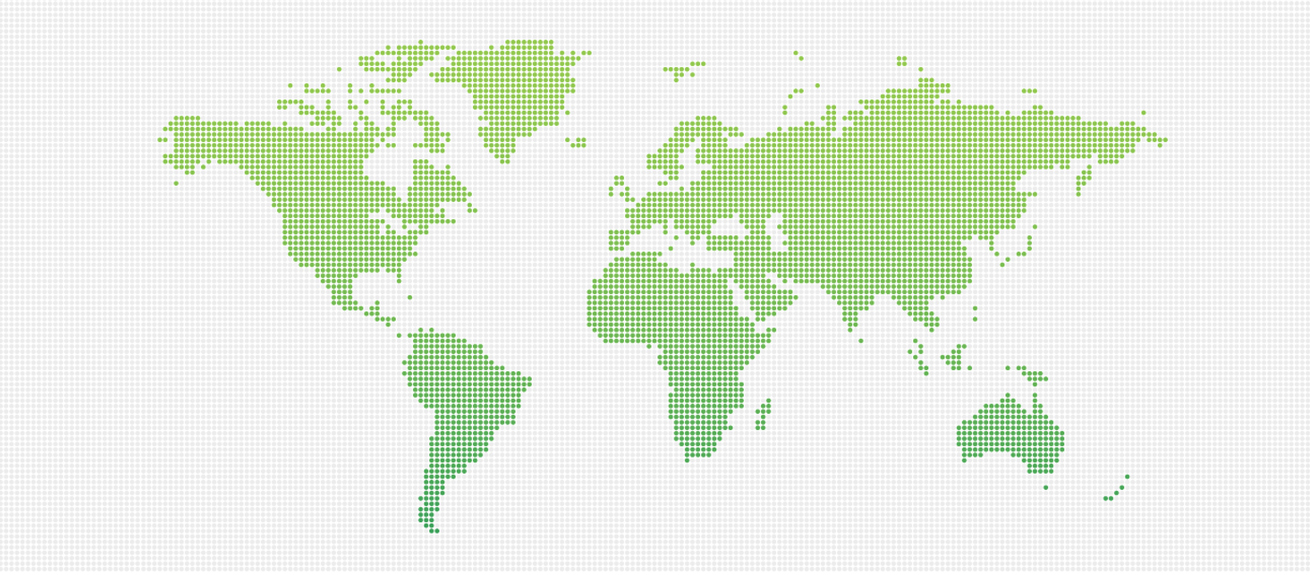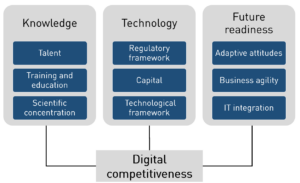
The IMD World Digital Competitiveness Ranking
The nature of competitiveness constantly evolves, affecting not only how businesses function but how countries perform today and will perform in the future. Economies are experiencing more rapid technological changes than in the past – from 3D-printing, robotics and neuro-technology to digital-currencies and e-participation.
The landscape of current capabilities and future prospects is changing swiftly and this poses a significant challenge for the IMD World Competitiveness Ranking – the leading annual report on country competitiveness – as it seeks to capture developments and benchmark the performance of the 63 nations it analyses.
Every edition of the IMD World Competitiveness Ranking incorporates new indicators to better reflect the competitiveness of countries. There are times, however, when a more drastic approach is required and the introduction of a new ranking is necessary. The IMD World Competitiveness Center thus deemed it fundamental to develop a new analytical framework to assess the state of digital affairs and further understanding of competitiveness. It created the IMD World Digital Competitiveness Ranking, which is much more focused and assesses the capabilities and readiness of economies to undertake the process of digital transformation.
Governments around the world are investing in scientific and technological infrastructure to keep up with the possibilities of the digital economy and enhance the prosperity of their citizens. While technological development is a necessary condition for the future well-being of an economy, it is not sufficient to augment value creation. Digital technology needs not only to be implemented, it needs to be explored to achieve two important goals – improve efficiency and enhance the range and the quality of services.
Digital competitiveness is defined as the capacity of an economy to adopt and explore digital technologies leading to the transformation in government practices, business models and society in general. The innovative capacity of a country is heavily rooted in areas such as the concentration of scientists and engineers in the workforce, the degree of protection of intellectual property and the depth of cooperation among the public, private and academic sectors. In the existing overall Competitiveness Ranking, these act as proxies for scientific and technological innovation. The new ranking complements the overall ranking by fostering a better understanding of the forces related to the digital economy as well as the latter’s contribution to country performance.
Gradual transformation
Technological transformation is gradual, requiring shifts at the organizational, institutional and structural levels. Organizations need to be able to recognize, communicate and assume the challenges brought about by the emergence of new technologies. Institutions must further their “openness and flexibility” to adapt to transformations and readjust relevant rules, regulations, norms and beliefs. Finally, the structural level is the degree of – according to Ulrich Dolata’s 2009 paper on technological innovations and sectoral change – “permeability of research, production, market, and demand conditions” in encouraging innovation, the development of new products, the emergence of new markets and the entry of new actors into relevant sectors. It follows that a digital competitiveness framework must encompass organizational, institutional and structural elements. The IMD World Digital Competitiveness Ranking captures such elements through three factors – knowledge, technology and future readiness.
Figure 1 illustrates the Digital Competitiveness Model.

Knowledge refers to the necessary infrastructure, which underlies the process of digital transformation through the discovery, understanding and learning of new technologies. Technology assesses the overall context through which the development of digital technologies is enabled. This context includes a supportive regulatory framework which allows for the efficient performance of business activities and the enforcement of relevant regulation while encouraging business development and innovation.
Future readiness examines the level of preparedness of an economy to assume its digital transformation. Competitiveness requires that available digital technologies be “absorbed” by society. The absorption of digital technologies needs particular adaptive attitudes,including the willingness of a society to participate in digital-related processes, for example, to engage in internet purchases. Readiness also requires business flexibility and implies that firms in a particular economy are able to transform their business models to take advantage of new opportunities. It also refers to the level of innovation that originates from the private sector. Readiness, finally, evaluates how well IT relevant practices and processes are applied by all actors.
A complete discussion of the methodology used to calculate all the rankings produced by the IMD World Competitiveness Center is available on our website (https://www.imd.org/wcc).
Identify strengths and weaknesses
Many technological changes lead to disruptions in the workings of government, businesses and society at large. A disruption is, by definition, something that cannot be accounted for. The issue for decision makers, therefore, is to be able to accommodate such drastic changes. We suggest that economies which exhibit high levels of adaptability and agility are better placed to face abrupt adjustments. A prerequisite, so to speak, for the exhibition of these characteristics is the stock of knowledge and technological competencies available in a country. The IMD World Digital Competitiveness Ranking provides decision makers with the ability to identify the strengths of their economy and improve their weaknesses.
Highly ranked economies with respect to overall competitiveness also, on average, place high in the digital ranking. Countries like Singapore, the United States, New Zealand, Belgium, Saudi Arabia and Jordan, among others, enjoy similar positions in both. Nevertheless, many countries exhibit differences, large and small, between the two rankings. Ireland, Luxemburg, China, Thailand, Cyprus and Indonesia, among others, are ranked in higher positions in overall competitiveness, while Sweden, Finland, Israel, Estonia, Slovenia and Croatia, among others, are placed better in the digital ranking.
As the nature of competitiveness changes so must the way of measuring it. Here we take into account the latest developments in digital technology to provide an effective tool for decision makers.
Arturo Bris is Professor of Finance at IMD and directs the IMD World Competitiveness Center.
Christos Cabolis and José Caballero are expert economists with the IMD World Competitiveness Center.
Research Information & Knowledge Hub for additional information on IMD publications
Digital transformation introduces a new set of parameters for firm innovation. Existing literature has found that family firms vary on their willingness to innovate. However, explanations of the factors that lead to a family firm’s (un)willingness...
The rapid advancement of generative artificial intelligence (GenAI) is unprecedented. Looking ahead at the job markets of 2030 and beyond, we can forecast the types of jobs and skills that may get automated. Alternatively, we can also see which ne...
Research Information & Knowledge Hub for additional information on IMD publications
Published by International Institute for Management Development ©2025
Research Information & Knowledge Hub for additional information on IMD publications
Research Information & Knowledge Hub for additional information on IMD publications
in I by IMD
Research Information & Knowledge Hub for additional information on IMD publications
in Small Business Economics 24 May 2025, ePub before print, https://doi.org/10.1007/s11187-025-01057-8
Research Information & Knowledge Hub for additional information on IMD publications
Research Information & Knowledge Hub for additional information on IMD publications
Research Information & Knowledge Hub for additional information on IMD publications
in I by IMD
Research Information & Knowledge Hub for additional information on IMD publications
in I by IMD
Research Information & Knowledge Hub for additional information on IMD publications
Research Information & Knowledge Hub for additional information on IMD publications







